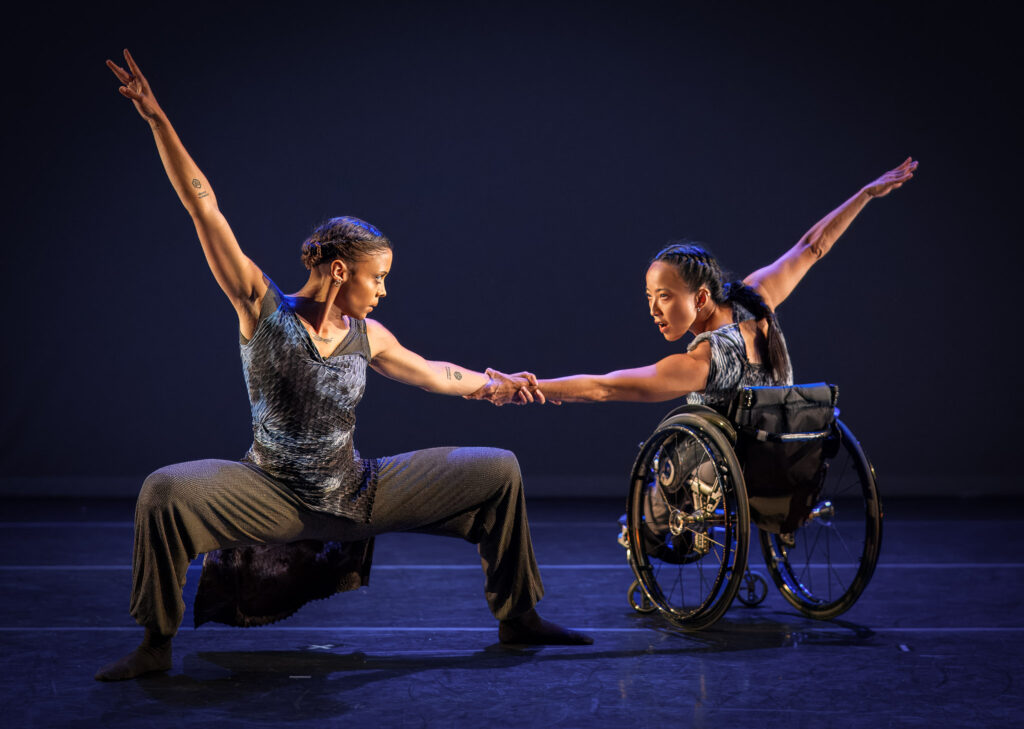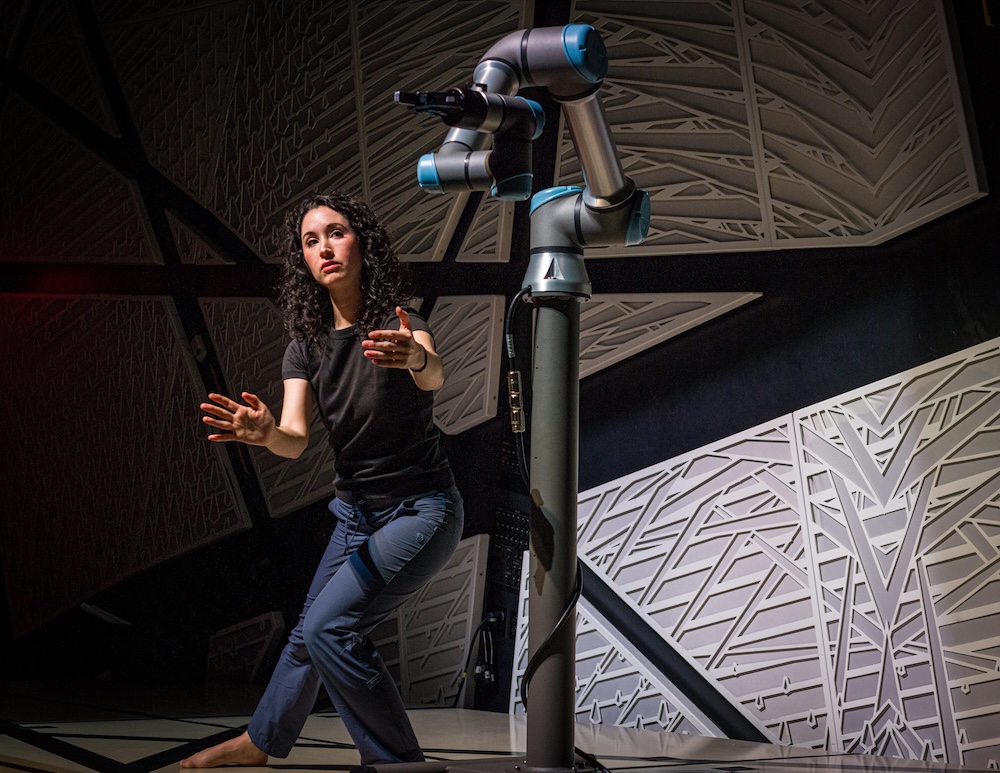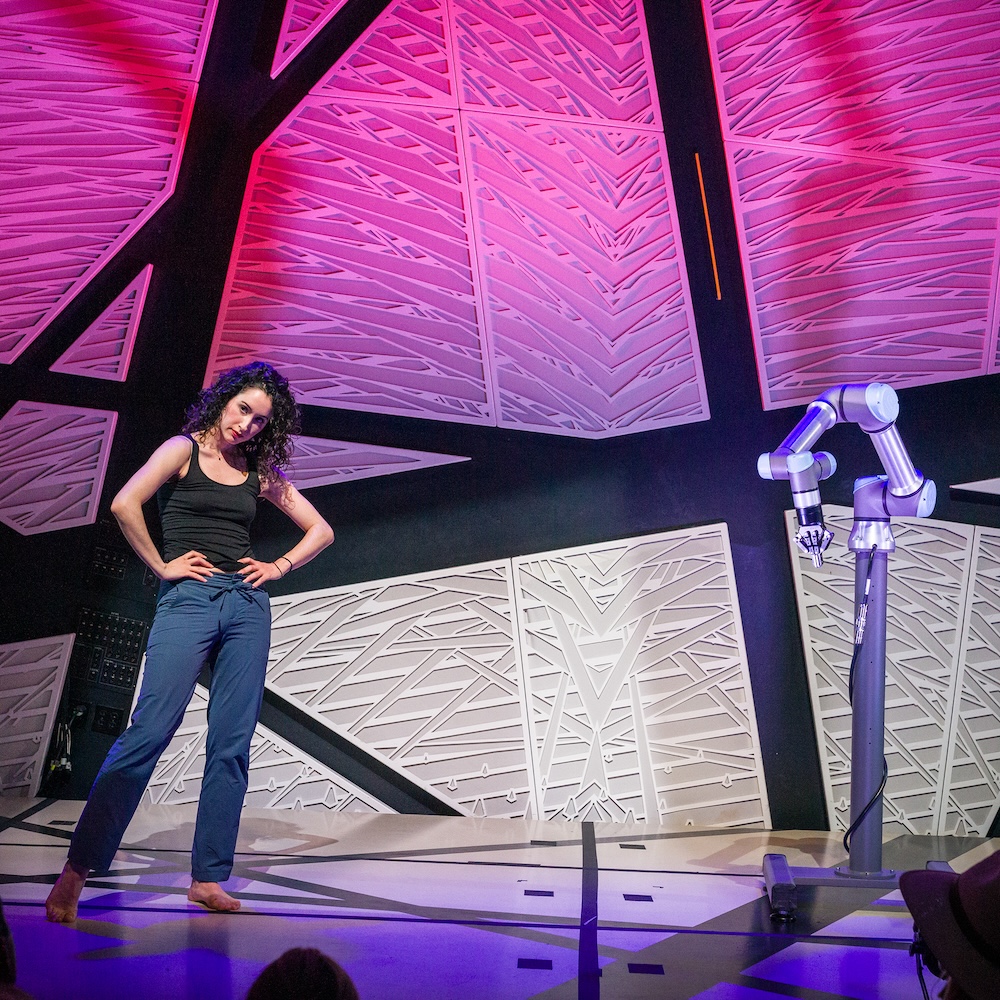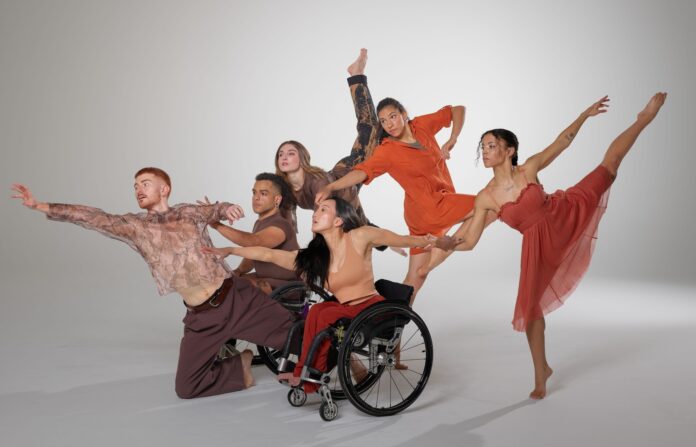Technology is a double-edged sword, or perhaps a multi-edged lightsaber would be more accurate at this moment. It is a tool that can extend our ability to save lives with innovative medical treatments, or destroy them with drones dropping bombs from a great distance away from the targets.
Technology that complements the power of the human body awaits the audience at AXIS Dance Company and Dr. Catie Cuan’s Wed/21 Stanford Live performance at Bing Concert Hall. AXIS, an ensemble of disabled, non-disabled, d/Deaf, and neurodiverse dancers, is bringing their latest work Kinematic/Kinesthetic, while roboticist Cuan will present her own piece of bot-assisted choreography, Manifold.
The evening’s performance will begin with a long duet danced by Cuan’s dancers Moscelyne ParkHarrison and Colin Frederick (who were both previously with the recently defunct Post:Ballet) inspired by the tree of knowledge, early stories about creation, and atavistic human rituals. A larger ensemble of six dancers will later join the couple in a large ceremonial and celebratory dance.

The complex works were the product of a lengthy creative process, AXIS artistic director Nadia Adame tells 48hills. “Our former director, Marc Brew, invited Ben Levine to take part in our 2021 ChoreoLab for disabled choreographers,” she says. “I saw a showing and thought it was very interesting, so I invited him to be part of our 2022 home season. He created a piece titled Tread with all the dancers on scooter boards and not in wheelchairs.”
A grant from the Hewlett Foundation and money from the MAP Fund allowed Levine and the rest of the AXIS team to spend a year researching robotics and developing the project.
“We started with the ExoPod, which he had worked on with students from Carnegie Mellon University,” says Adame. “It moves around with the dancers. There was an elbow with three joints that gives the dancers extra extension in the upper limbs, and a telescopic crutch was built with students from the University of Maryland.”
The company also came across a power wheelchair called Omeo that is controlled by how weight is distributed on its seat. No joystick is needed in order for it to go forward, backwards, or turn. Torso movements alone provide the device’s directions, which AXIS found gives the dancers amazing freedom.
“The idea from the beginning was to show how technology supports or enhances the movement of all dancers, not only the disabled dancers, but all dancers,” emphasizes Adame. “If we have telescopic crutches that propel us up, how would that inform our movement?
Help us save local journalism!
Every tax-deductible donation helps us grow to cover the issues that mean the most to our community. Become a 48 Hills Hero and support the only daily progressive news source in the Bay Area.
“I thought about, how much does technology need the human person to be there to make it work? Can we deconstruct it and figure out what the deconstruction does to the movement so we’re not using the robotics as they are meant to be used? We’re using them in a more abstract way, because technology has limitations,” she continues.

For her part, Cuan straddles both sides of the tech-dance equation, having created what she calls “choreorobotics.” She has danced professionally with Metropolitan Opera Ballet, the Lyric Opera of Chicago, and other contemporary, commercial and musical theater projects, and continues to dance with the robots that she helps design and refine. She earned an MS in mechanical engineering and a PhD in robotics and AI from Stanford, where she is now a post-doctoral research fellow at the new Stanford Robotics Center, in addition to being an artist-in-residence at the Exploratorium, San Francisco’s renowned science museum.
“I’ve danced my whole life,” says Cuan. “I’m Cuban, so as my dad always says, ‘If you don’t know how to dance, you’re probably not Cuban.’ I started training formally in and out of my youth.” That being said, “I always loved math and science and interned at Google a couple times when I was in college,” she continues.
“The way I got interested in robotics was when my dad was in the hospital for a while,” says Cuan. “He was surrounded by all these machines that were beeping and blooping, and that were supposed to be taking care of him. It struck me that we needed artists to design these experiences with intimate machines, because artists know how to change emotion. When you’re very vulnerable and sick, your emotions actually have so much to do with how quickly you heal. Your optimism to be out of the situation that you’re in struck me as an obvious rationale to apply my artistic skills to the design of different kinds of machines.”
“I always wanted to work with robots because they’re embodied. I went to a conference that Sydney Skybetter runs called the Conference for Research on Choreographic Interfaces,” she continues. “I met Amy LaViers, who was the head of a robotics lab at the University of Illinois at the time. We had an immediate connection and when I asked to be the artist-in-residence at her lab and she said OK.” A few months after her time at UI, Cuan applied to grad school at Stanford.

During the two-year residency at the Exploratorium, Cuan explains that, “the project started from these two guiding questions I had: what does it mean to be cared for and how does it feel to be held? It’s been six months that we’ve been fabricating this particular robot.
“I tried a lot of different permutations of what I thought that could look like and we ultimately decided to start building this nine-foot-high robot hand on a mobile base,” she says. “It uses AI to learn how to endear itself to the Exploratorium audience. We worked with a tailor and a fashion designer, so the exterior of the robot is quite beautiful. It’s basically couture, with hand applique and silk organza, because we wanted it to be very feminine.”
Fittingly, the Stanford Live event pays special attention to accessibility, with ASL interpretation, audio description by Michael Whitson of Gravity Access Services, and a pre-show access tour an hour before the program’s start time. There will be wheelchair and additional accessibility seating.
Cuan says, “It’s really about this relationship between humans and our tools and just how integrated we are. I’m obviously a big fan of tools, because I’m a roboticist, but I also think that because we, as humans, can coordinate in large groups to use tools in a manner that allows our species to change the planet in a way that has never been observed before.”
AXIS DANCE COMPANY AND DR. CATIE CUAN Wed/21. Bing Concert Hall, Stanford. More info here.




